What is Autism?
According to Autism Speaks, the term “autism” or “autism spectrum disorder (ASD), refers to a broad range of conditions characterized by challenges with social skills, repetitive behaviors, speech and nonverbal communication. In order to be diagnosed with autism, a child must have each of the following two conditions present in early developmental life:
- Persistent deficits in social communication
- Restricted/repetitive patterns of behavior, interest, or activities
Speech Therapy for Autism
Since social communication impairments are a defined feature of the autism diagnosis, speech therapy is a common recommendation for children with autism. Speech therapy for autism will target improving the child’s social communication and interaction skills and helping them become more independent and confident in their environment. The following speech therapy goals that should be considered for all clients with autism spectrum disorders.
Speech Therapy Goal 1: Establish Functional, Spontaneous Communication
The first goal with any child who has autism is to make sure that he or she can communicate functionally, and spontaneously. This means that the child needs to be able to communicate his basic wants and needs to those around him without needing to be prompted through it (the adult shouldn’t have to say “what do you want?” or “use your words”).
If the child already has that down, awesome! You can move on. If not, stop here! Do not pass go, do not collect $200! This step is a MUST!
Each child with autism will need this area of speech therapy to look slightly different. Some children will need alternative means to communicate because they won’t be able to speak. Others will speak just fine but will help learning the right words to use in the right situation. A speech-language pathologist will be able to customize therapy to meet the needs of each individual child with autism.
Using AAC for Children with Autism
If a child’s speech is not adequate for functional speech (meaning that the child isn’t talking or isn’t able to communicate all of his/her wants and needs), it can be helpful to introduce various forms of augmentative-alternative communication (AAC) until you find a method that works for the child. Remember, each child is different so different methods will work differently for each child. Here are a few options to try:
- Voice-Output AAC Device: This device will speak a message when the child pushes a button or hits a switch. These can be as simple as a single button with a single message and as complicated as a touch-screen device with buttons and folders that change as the child pushes certain buttons. See examples of AAC devices here.
- Picture Communication System: Some children benefit from using pictures to communicate. This makes communication much more concrete for them. You can start by using a simple communication board and having the child point to what he wants. Or, you can use a more complex system like the Picture Exchange Communication System (PECS).
- Sign Language: Some children benefit from using their own body to communicate by using sign language. This has been used very successfully with children with autism and has even been shown to get kids talking with their mouths more quickly than they would have without using sign language.
Helping Children Use Language Spontaneously (without being prompted):
Children with autism often have difficulty with using language spontaneously. They may speak when told to or in response to specific questions but won’t speak up when they need something or when they are upset.
For these children, it’s important to work on fading the amount of prompts that you are giving so that the child does more and more independently each time. For example, at first you may have to tell the child exactly what to say in each situation. Then, you can fade back to a prompt like “use your words”. Then, you can fade back to a visual cue like a picture that says “use your words” or shows someone talking. There are many ways to fade cues so that is just an example.
Another alternative for helping children who are having trouble using language spontaneously is to use a PECS system like mentioned before. This structured program has been very successful with increasing spontaneous communication in children with autism.
It also may be helpful to start with teaching the child basic requests (as those will be the most motivating for him) and then move on to other types of communication such as commenting, greeting, asking, etc. once requesting has been established.
Speech Therapy for Echolalia
Echolalia is the term for when a child repeats what we say back to us instead of coming up with his/her own sentences. This is common in children with autism who are learning to speak. Sometimes, we hear parents say “he didn’t speak at all and then one day he started speaking in full sentences”. This is because these children are learning sentences as one unit. Later, they will learn how to break those sentences down into single words and then rearrange them to create their own sentences.
For more resources on helping children with echolalia, click here
Functional Communication Training for SLPs and Others:
Need some more help with learning how to improve functional communication in children with autism? Check out our functional communication course bundle here. It includes video training courses along with printable therapy materials and activities.
Click Here to Join The Hub to Access all of our Courses and Materials
Speech Therapy Goal 2: Improve Social Communication Throughout the Day
The next thing that all children with autism will need to some degree is social instruction. Children with autism often have a problem with understanding socially acceptable behavior. They don’t always know how to act or behave in various social situations. Since school is basically just one big social situation, that can make learning environments especially hard for them.
Again, the specific therapy techniques and strategies for this area will vary depending on the child and their individual needs. But the key is for this social instruction and support to continue throughout the day. Children with autism often have difficulty transferring skills learned in one setting to a different setting. For that reason, they need to work on social interactions in more places than just during speech therapy sessions. Educators and caregivers should carry-over social instruction in other settings as well.
Direct Instruction of Socially Acceptable Behaviors:
It is important to teach children what behavior is socially acceptable in various environments. This includes what the child should do and say in social situations as well as how he should listen and attend. For young children, you will choose goals for basic skills like listening to a teacher, answering questions, and following directions. For older children, you will choose goals like group conversations and being a good friend. Again, the social skills chosen will depend on the needs of the child.
Here are several strategies that have been proven effective methods of social instruction for children with autism:
- Visual Supports: Visual reminders placed in the room or presented by adults help the child remember the expectations for that situation.
- Social Stories: Books designed to teach a child the expected behavior in various situations
- Video Modeling: The student watches videos that demonstrate the expected behaviors
- Role Playing: We can set up situations in which the child can practice necessary skills before using them in real life situations
Speech Therapy Goal 3: Improve Peer Interactions
Since children with autism often have a difficult time with peer interactions, these skills must also be directly taught. All children with autism struggle with this to some extent as part of the nature of autism. However, you will target significantly different skills depending on the age and developmental level of the child you are working with.
Peer Interaction Goals for Younger Children:
Here are some goals for children who are just beginning their peer interaction training:
- Play skills: Teach the child how to play with other children and get along during play.
- Responding to Name: Teach the child to respond when someone says his name.
- Establish Joint Attention: Help children tune into those around them.
Peer Interaction Goals for Older Children:
These activities are better for older children who are struggling with peer interactions:
- Target Conversational Skills: Look at social skills that the child is lacking during normal interactions with other students and adults.
- Teach Perspective-Taking: Help these children understand how to see things from another perspective
Speech Therapy Goal 4: Generalize Skills to the Regular Education Environment
One of the most common requests I hear from parents of children with autism is “My child needs more time with the speech-language pathologist”. I completely understand why they want this! The speech therapist is the person who is helping their child communicate better so more time with that person should equal better communication, right?
Unfortunately, that’s not exactly how it works.
The Trouble with Generalizing
Children with autism tend to have trouble generalizing skills. For example, if you teach a child with autism to count to 5 using the same 5 yellow cups at the kitchen table and you never practice counting anywhere else, the child will do great at counting to 5 in that exact situation but may not be able to transfer that to counting anything else.
The same goes for communication. If a speech-language pathologist teaches a child with autism to communicate with her in the speech therapy room, it doesn’t necessarily mean that the child will then start communicating with other people and in other settings.
Instead, the child must practice the same communication skills with a variety of different people and in a variety of different settings. For that reason, it is vital that the child does not spend every waking moment with the speech therapist. We want the child to communicate in any situation, not just when the speech therapist is present.
How to Help Children with Autism Generalize Communication Skills
If the child needs to work on communicating better, then the answer is not necessarily just to add more time with the speech-language pathologist. Instead, the speech therapist must train the other adults that interact with the child on how to do the same types of instruction, prompting, and modeling that she does.
When the speech therapist trains the other adults, the child will make faster progress with his communication skills because he will be getting the same instruction from multiple sources and he’ll be able to practice those skills in the natural environment (at home and in the classroom as opposed to just in the therapy room).
Educator and Caregiver Training for Children with Autism
Speech therapy services for children with autism can look very different depending on a lot of factors. Each speech therapist will need to determine which services will be best for each child. Here are some different ways that speech therapy services may be assigned to help the child make optimal progress:
- Direct Therapy Minutes: The therapist provides direct therapy to the child, often in an isolated setting like the therapy room. This is often best for introducing a new skill when fewer distractions are necessary.
- Push-In Therapy Minutes: The therapist provides therapy to the child within the regular education environment. This is often best for generalizing new skills to a more natural environment and modeling teaching strategies for the classroom teacher.
- Consultation Minutes: These may be called different things but these minutes are written into the IEP as time when the speech-language pathologist will work with the classroom teacher (or parents) to show them the techniques that they can use to help the child learn to communicate in other settings.
As you can see, there are many different ways to serve children with autism and adding more direct therapy minutes isn’t always the best solution. Each student needs an individualized plan including a combination of different services.
Speech Therapy Goal 5: Target Remaining Speech/Language Skill Deficits
Finally, we look at other communication skills that may be impacting the child with autism. Once the child begins to make progress on these larger items, we can begin to address some of the smaller issues that may also be impacting the child’s communication. Here are a few areas that may need to be addressed:
- Speech Sound Errors
- Errors in Grammar
- Problems Asking and Answering Questions
- Difficulty with Figurative Language
Source: http://www.asha.org/Practice-Portal/Clinical-Topics/Autism/
Additional Resources for Autism Speech Therapy:
Check out our additional resources for working with autistic children here:

About the Author: Carrie Clark, MA CCC-SLP
Hi, I’m Carrie! I’m a speech-language pathologist from Columbia, Missouri, USA. I’ve worked with children and teenagers of all ages in schools, preschools, and even my own private practice. I love digging through the research on speech and language topics and breaking it down into step-by-step plans for my followers.
Fun Fact: My family’s favorite vacation spot when I was a kid was Myrtle Beach, South Carolina. My favorite restaurant there is Sea Captain’s House. They used to have a shrimp in phyllo dish that was my favorite, but sadly they stopped serving it! We still love going though and it’s been fun to bring my kids there now, too!
Connect with Me:
Podcast: Play in new window | Download | Embed
Subscribe: RSS

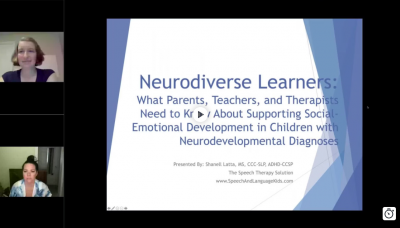
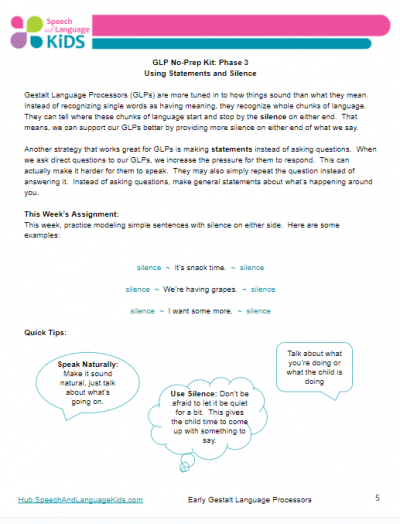
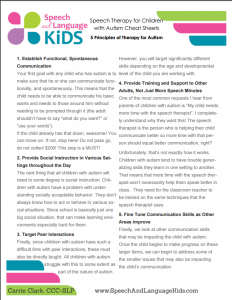
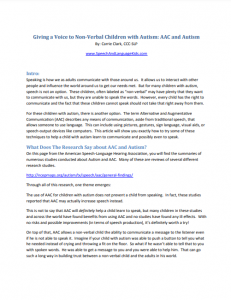
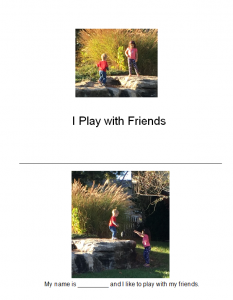







This is some really good advice, I particularly like the stuff about using visual supports to help children understand socially acceptable behaviors. After all, children with autism do have quite a hard time learning new things sometimes and may need a little help. Of course, you need to make sure that have the right supports and that the child can understand the relation between them and the real world.
Informative & helpful post. For people with autism, pragmatic speech is almost always a challenge at some level. Obviously, a non-verbal person is struggling with very different challenges than a highly verbal person, but both are likely to need help in understanding facial expressions, non-verbal cues, turn taking, and so forth.
if the child have difficult with focus, pay attention to what you are saying, commenting, in other words, he just ignoring you and doing his own thing. Will it consider to be under autism spectrum ?
Hello, Henry!
Thank you so much for reaching out. Unfortunately, we get a ton of questions every day about how to solve specific speech/language problems. Since we have such a small staff, we aren’t able to answer every question that comes through on the website, social media, or via email. If you are a parent, we suggest you reach out to a local speech-language pathologist who can work with your child directly and answer your question.
If you are another speech-language professional, we have created a membership where we pay a full staff to answer questions like this on a regular basis. We would be more than happy to answer your question inside the membership program. We’re able to answer more questions in here because we have a full library of questions that we’ve already answered so our staff can either link you to the answer if it exists, or write you a custom response if needed. We’d love to see you inside the membership!
Click Here to Become a Member: https://www.slpsolution.com/pediatric-signup/.
Speech therapy is a treatment that can help improve communication skills. It really helps people to communicate. I really appreciate you for providing such great content. Thank you
Wow, I just read this blog. I really feel good and learned many things from it and I can say that this blog can help many people like me so I’m going to share this blog.
Your information is really helpful. Pay attention to your kid’s behavior. Speech and language therapy is frequently one of the first and most effective treatments that are advised by all medical professionals when your child is diagnosed with autism.
Thanks for sharing the Informative & helpful article about speech therapists.
Social stories have been super successful for me! Thanks for highlighting those as a good resource.
As a parent, navigating the complex journey of speech therapy for my child with autism was overwhelming initially. This comprehensive post offered me clear and empathetic guidance when I was desperately seeking it. I recall the joy when my child communicated their needs for the first time; it was like unlocking a door to a world that had been closed off. This blog brings back those memories and the important role speech therapists play in enhancing the lives of those with ASD.